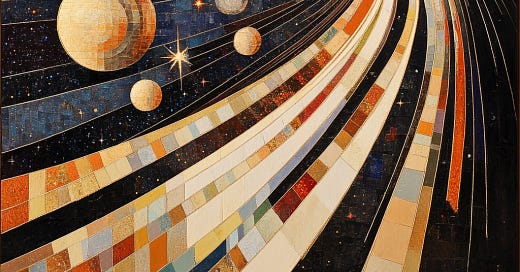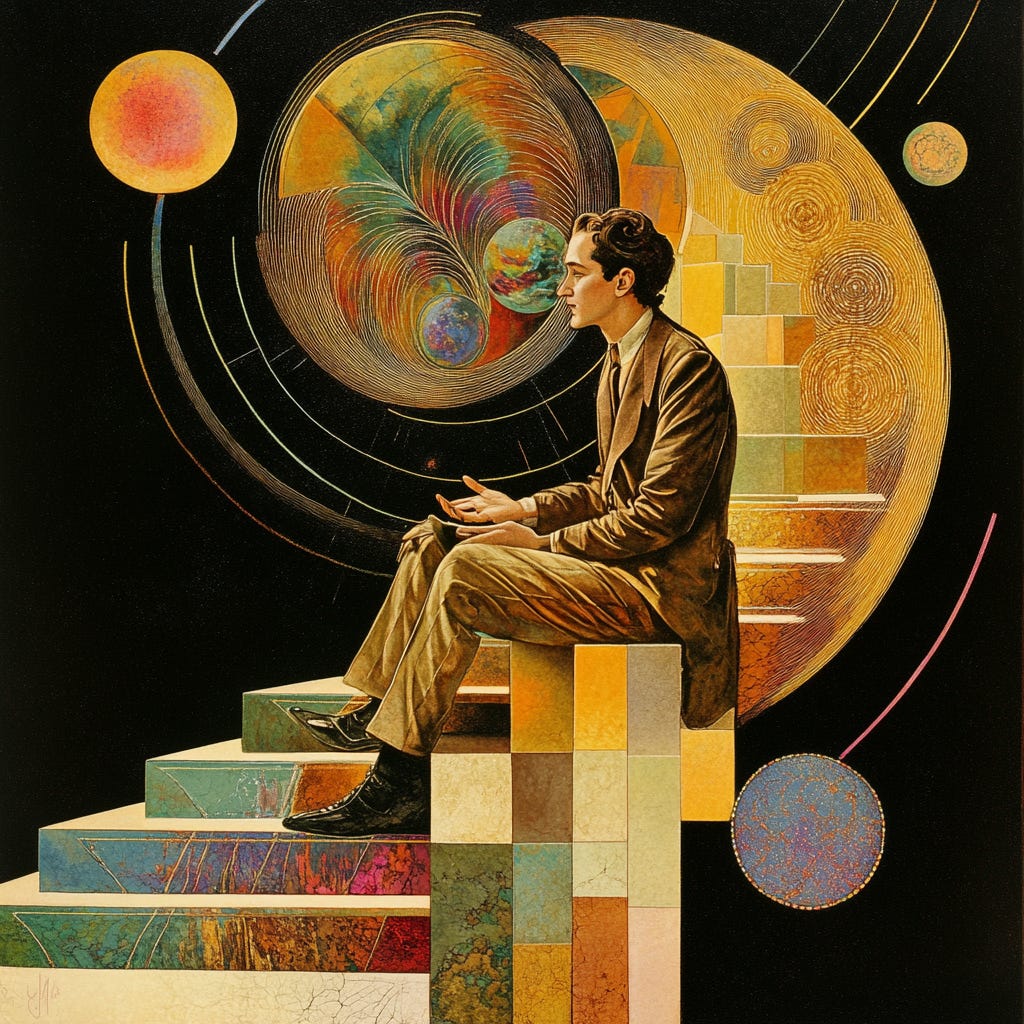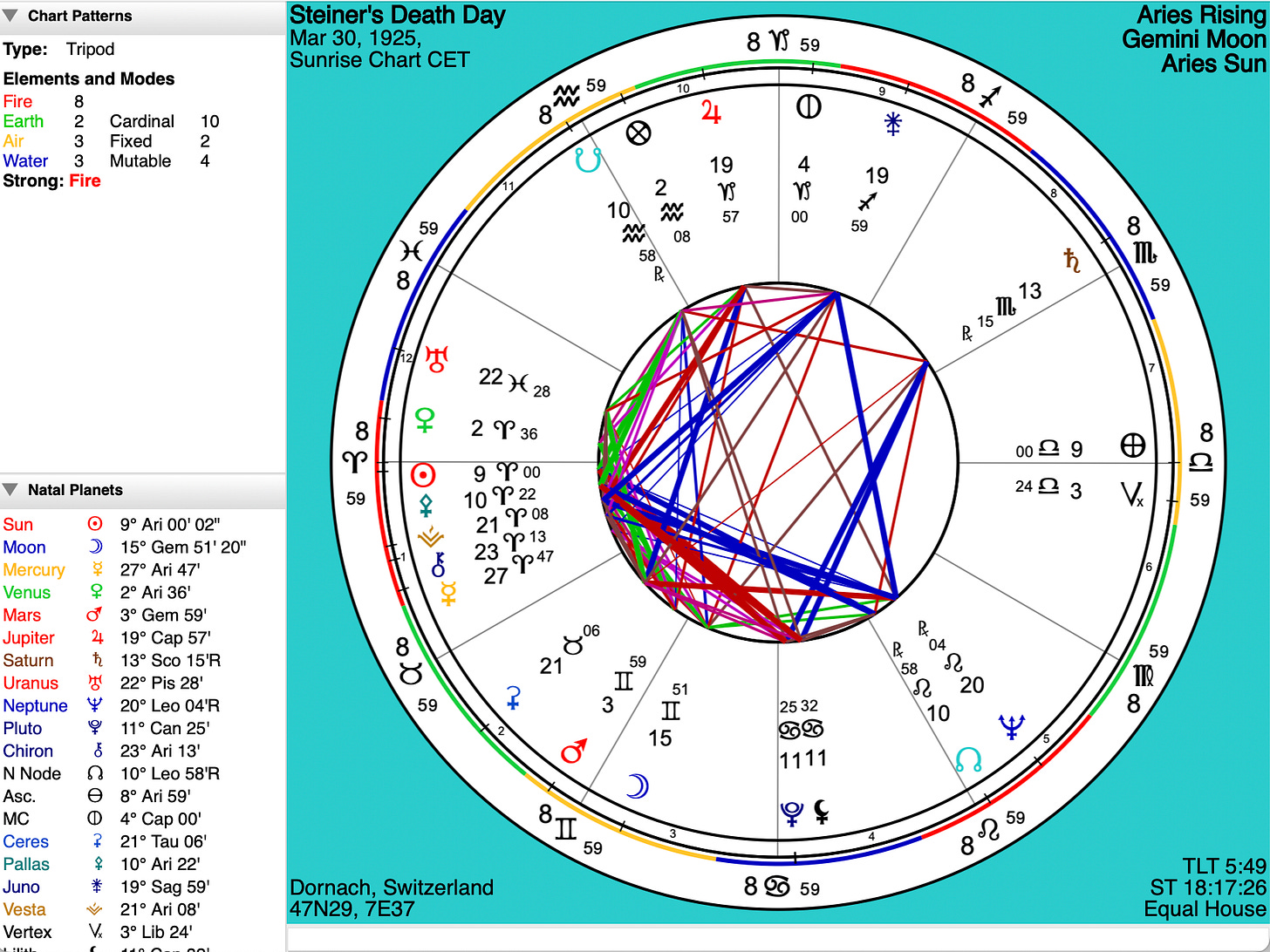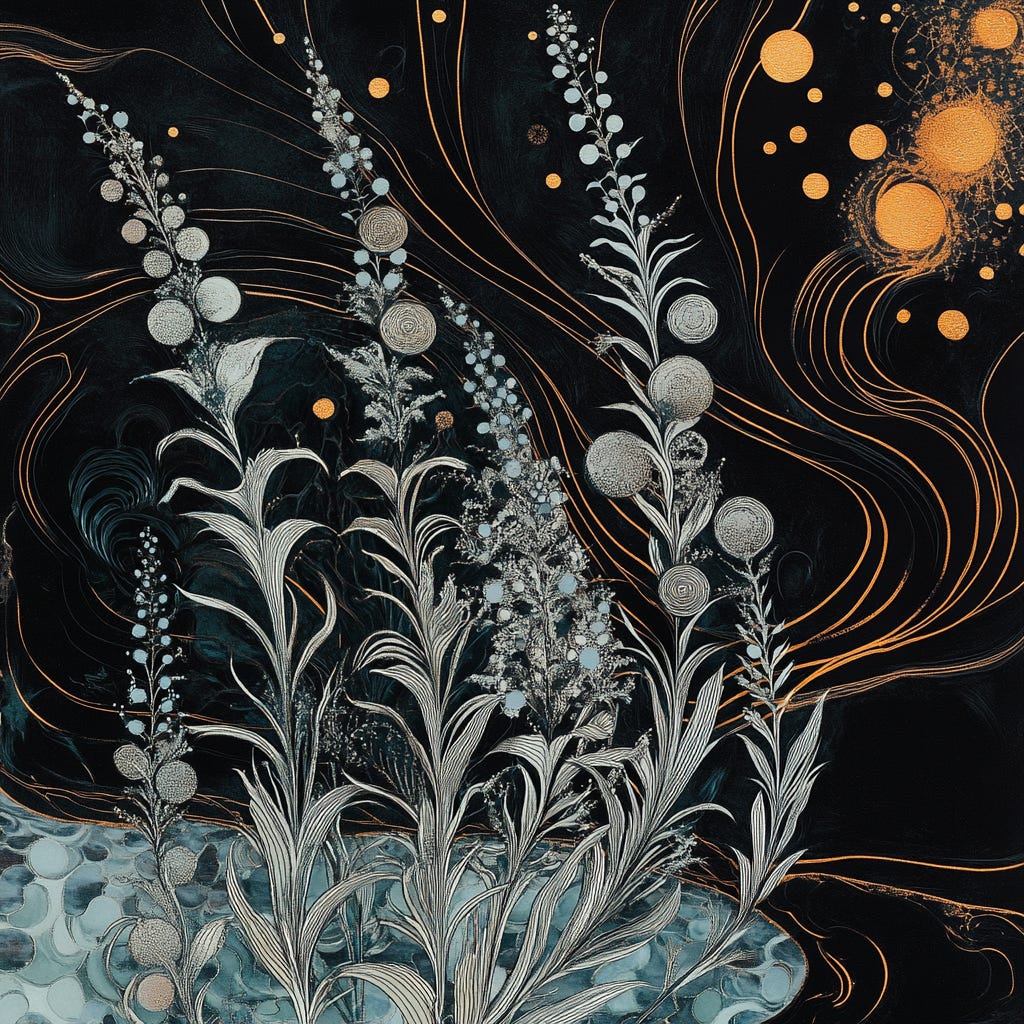Today is the 100-year anniversary of Rudolf Steiner’s death. As such, I thought I’d take some time to reflect on his astrology. This will be in part a biographical-astrological sketch and in part a musing on thinking about astrology in the context of our development or metamorphosis as individuals.
For those of y’all that don’t know, Rudolf Steiner’s anthroposophy is a big part of my life. From 2019-2023, I lived in Dornach, Switzerland, on the campus of the Goetheanum, a building he architected that houses the School of Spiritual Science (Hochschul für Geisteswissenschaft) and its twelve Sections, which include the worldwide movements of Waldorf education, biodynamic agriculture, and Anthroposophical Medicine. I worked and studied at the Section for Mathematics and Astronomy and the Rudolf Steiner Painting School, and I’m still an editor and translator at Das Goetheanum, the weekly journal Steiner started in 1921.
Through this time, I also got to participate in a colloquium of individuals interested in exploring the intersections between astrology and anthroposophy, which, although Steiner made frequent reference to the planets and stars, were usually divorced. One of Steiner’s central aims was to enkindle the free, self-directing spirit of the human being, and, even in Steiner’s time, astrology could easily become a self-limiting excuse to give up one’s agency. One of the main presenters in this colloquium focused on the astrology of the death chart, which Steiner suggested was a useful tool for karmic research. Steiner said that the moment of our death was a sort of cosmic exhale, wherein our spirit gives back to the starry spheres what we have worked over, developed, and transformed in our lives on Earth. He said that when we’re reborn, the constellations of the different planets resemble the moment of death from the previous lifetime.
I really appreciate this view of our relationship to the stars as a developmental and evolutionary process. This has been picked up in modern astrological discourse: although there are many benefits to the perspective that seeks to understand the rigid, deterministic contours of fate and destiny, astrology is increasingly appreciated as an artistic path, one that is filtered through the intricate contexts of our lives. We see this in studies of time twins who express radically different life paths, as well as in explicit traditions such as Evolutionary Astrology, where it’s understood that the astrological archetypes can express along a spectrum of advances in consciousness. Here, we can appreciate the natal chart as a single point within a process of metamorphosis. And how could it be otherwise? We are here to learn lessons, to understand and adapt, to rule our (inner) stars and express more coherent, dynamic, and creative manifestations of the archetypal forces which give rise to our being.
Rudolf Steiner said he was born on February 25th, 1861, in Kraljevec, Croatia, at 11:07 pm. This chart seems to check out with an appreciation of Steiner as an individual born with immense spiritual gifts, a destiny as a powerful leader, and someone with intense willpower. Indeed, it’s thought that he was a reincarnation of Aristotle and Aquinas, ideas that I don’t necessarily take as facts but as interesting ideas nevertheless.
One of the most striking features of this natal chart is that Jupiter was in Leo, one minute away from being exactly conjunct the midheaven, the top of the chart, which represents one’s vocational calling and relationship to the bigger and wider world. Jupiter, an expansive, generous, and wisdom-loving planet, takes on a particularly expressive and courageous manifestation in Leo, and indeed, Steiner was one of the most prolific teachers of all time—for about 25 years, he was travelling around Europe non-stop, giving up to three lectures a day, on top of his own writing and collaborative work. The publication of his transcribed lectures is still ongoing, and he is already the author with the most attributed works attributed of all time.
This Leo Jupiter is ruled by the Sun in Pisces and the 4th House, which directs us to the realm of down-to-earth spirituality. One of Steiner’s earliest spiritual experiences occurred when he was a child, when he encountered the ghost of his aunt, who had just passed away, although Steiner did not know it yet. His vivid experience of her gave him an early conviction of the reality of the spiritual realm. We can further trace these spiritual gifts to the Mercury-Neptune conjunction in late Pisces—very close to where Neptune is today! Mercury describes our mental aptitude, Neptune is the most spiritual of planets, and Pisces is the most spiritual of signs. Likewise, one of Steiner’s earliest teachers was an herb-gatherer, Felix Koguzki, who had strong relationships with nature spirits.
This Piscean quality is balanced out by Steiner’s strong Virgoan nature, though—he was born on a full moon, and since he was born at night, in some sense, his Virgo Moon is more important than his Pisces Sun. His Saturn, also nearby in Virgo, and Capricorn North Node gave this an incredibly admirable quality of dedication and ambition. Despite being born under humble circumstances in a rural portion of the Austro-Hungarian empire, Steiner was a hard worker and serious student, going to school at the Vienna Institute of Technology. Through school, he worked as a tutor (working wonders on a child with hydroencephalopathy) and studied to become a science teacher, a very sensible goal.
He also was deeply interested in literature, and eventually, though the help of one of his teachers, got a position at the Goethe Archive editing Goethe’s scientific papers. Goethe was like the Da Vinci of German culture, a true hero whose literary works such as Faust continue to be a core part of German culture. He was also a scientist and developed a scientific method that ran counter to the Baconian empiricism that was on the rise. Goethe argued that each object of study required its own method of study and that the fullness of the researcher’s experience and relationship to the object of study were to be incorporated in the process rather than stripped away. Above all, acute powers of observation and a capacity to imagine the metamorphosis of an object’s metamorphosis and development were cultivated. Steiner saw his own spiritual scientific research as an outgrowth of Goethean Science—and together, they are a perfect blending of the Virgo and Pisces archetypes.
The Scorpionic and Plutonian element of Steiner’s birth chart are also not to be underestimated. He was born with Scorpio rising and a Pluto-Mars conjunction on the Descendant. This combination supercharges the willpower of an individual—it gives rise to a relentless, obsessive personality, which is not easy, especially socially. Some of Steiner’s critics down the line expressed concern that he was hypnotizing audiences. On the flip side, Steiner’s success was clearly not his solely own, but rather a result of his capacity to work intensively with partners—a common feature of charts which emphasize the 7th house or Descendant. It was said that he often responded to the questions brought to him by individuals. He worked with Ita Wegman to bring forth Anthroposophical Medicine and Emil Molt on Waldorf eduction, as well as Marie Steiner on Eurythmy and Edith Maryon on the Representative of Humanity sculpture.
An integral part of this pro-social quality is his Venus in Aquarius, at the Imum Coeli, the bottom of the chart. Here, he had an appreciation of relationship as a sort of chalice for higher impulses from the spiritual realm. The full ideal of this would come forth in his theories of Social Threefolding, which imagined a social order governed by solidarity, equality, and freedom, with each operating in their proper sphere. Inspiration for Social Threefolding can be found within the communal life of bees, wherein the sexual impulse is transmuted into dedication toward the bigger wholes of which the human being is a part, beyond the ties of family and romance. Social Threefolding would have likely established itself as a much bigger political force in the twentieth century had inflation in Weimar Germany not been so outrageous, forcing many of his initiatives into bankruptcy.
The causes of Steiner’s death are uncertain. Some say he was poisoned, and he had no shortage of adversaries, especially as his work started to take on political and economic dimensions. Indeed, the First Goetheanum, which was built during the First World War (with the sounds of the battle on the border of Germany and France, which are both visible from the Goetheanum grounds, in the distance), was burned to the ground by arson on New Year’s Eve 1922/23. Many think that the destruction of this structure, a modern day mystery temple, which Steiner poured so much of his life force into, precipitated his decline. Less than two years later, he took to his sickbed in the studio where he carved The Representative of Humanity and died six months later.
In Steiner’s death chart, we see an image of his legacy. It is a picture of a metamorphosed life, wherein his strivings bore fruit in the form of an enduring movement which continues to benefit and inspire millions across the globe. It is the chart of a leader, administrator, and communicator—the primary roles that he took on in directing the Anthroposophical Society toward the end of his life.
I haven’t been able to find the exact time of Steiner’s death, so some of the information that constitutes a full chart is missing. Nevertheless, we see some striking features, particularly the stellium in Aries. The Sun is exalted in Aries, depicting a golden, radiant, and assertive clarity. The Sun is here conjunct Pallas Athena, describing a quality of strategic perception and foresight—indeed, he was very concerned with establishing the Society in such a way to ensure its long-term success in becoming a cultural force, especially in light of what he foresaw as the intensifying anti-human forces of modernity. He understood himself as fighting a spiritual battle for the future of the Earth, and this combo depicts an adept general.
This Aries energy is ruled by Mars in Gemini, where the Moon is as well. Here, we can see the importance of communication and correspondence for Steiner—indeed, he was writing until his death, as well as continuing to dispatch for books from the Basel library and continuing conversation with important partners as he could. His intellectual legacy is obviously incredibly vast, and although it’s one with plenty of intricate maps and systems, it’s also one that first and foremost seeks to support the mental and spiritual faculties of humanity—anthroposophy is a dynamic path of developing knowledge and research. The anti-human forces Steiner was combating were in part those that deadened thinking, and Steiner advocated for a sort of living thinking that incorporated and strengthened the heart and ennobled the will.
Jupiter’s presence in Capricorn is also notable in this chart. Here, we can speak about a search for expansion or growth by building something well-structured or enduring. While Capricorn is technically Jupiter’s fall, and I imagine the administrative work Steiner had to do toward the end of his life was less juicy than his travel or spiritual research, it was clearly an important part of his legacy. Indeed, he refounded the Anthroposophical Society about a year before he died, also giving the Foundation Stone Meditation and the First Class lessons—signs of substantial concern with the structure of the initiatives he brought forth.
If we look at the death chart in relationship to his natal chart (which would have been the transits that he was experiencing), we can see a number of substantial connecting threads. It was clearly a moment of intensity and transition for him, but it also describes a sense of completion of his mission—a sense that he had adeptly navigated the realms of life that were very important for him and could exhale a legacy. Jupiter in his death chart is on top of his natal North Node in Capricorn—for me, a sign that he had accomplished a task of navigating adeptly the structures, traditions, and administrations of the world. Strikingly, Saturn is on top of Steiner’s natal ascendant, an explicit indication of a time of endings or limitations. Likewise, we can also see that Neptune was on top of his natal Jupiter at the midheaven—a time of spiritualization that seemed to dissolve his physical form.
In many respects, in Steiner’s death chart, I see something closer to who Steiner became, speaking of a way in which the natal chart as an initiating impulse developed and blossomed into something entirely different. Exercises like these have given me an appreciation that, although the natal chart is always a reference point (even for a great initiate like Steiner, Saturn transiting his ascendant and Neptune transiting his midheaven depicted a major transition), we are always in flux and flow as individuals, developing along circuitous, spiralling pathways.
Of late, I’ve been appreciating looking at the natal chart within an entire sequence of someone’s existence—we can look at the major happenings of our time in the womb (especially the eclipses), as well as our early years (through the secondary and tertiary progressed charts), which we know are incredibly psychologically influential through the course of our life. Likewise, we can appreciate the natal chart as a series of images that describe an optimal course of development for us which we may or may not live up to. In German, we can see a relationship between the words for image (Bild) and learning/development (Bildung), and astrologically, we might think of both of these as pertaining to the lunar sphere, which relates to our forces of growth, reproduction, and imagination, filtering and condensing the rest of the starry sphere into our somatic and psychological experience.
I hope this musing has been edifying! Of course, if you’re interested in understanding your own astrological metamorphosis—how your chart reflects both your origins and your potential for growth—I would love to offer you a reading. Reach out, and together we can explore the unfolding patterns of your journey.
Warmth,
Charlie









Thank you, Charlie, for this incredible picture of Rudolf Steiner's life and death, and also for your explanation of the significance of the death chart, and of all our charts as pictures of our evolution. Well done!